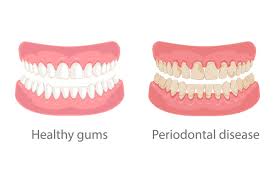What is Gum Recession (Periodontitis)? Causes, Symptoms, and Remedies
What is Gum Recession . Gum recession, also known as periodontitis, is a prevalent dental issue that affects millions worldwide. Characterized by the gradual loss of gum tissue, this condition can expose the roots of the teeth, leading to sensitivity, decay, and even tooth loss if left untreated. Understanding gum recession is essential to maintaining optimal oral health. Below, we delve into the causes, symptoms, and remedies for gum recession.
What is Gum Recession?
Gum recession occurs when the gum tissue surrounding the teeth begins to wear away, pulling back and exposing the tooth’s roots. This condition is often a warning sign of underlying oral health problems, such as gum disease or poor oral hygiene. When untreated, gum recession can progress to periodontitis, a severe form of gum disease that damages the supporting structures of the teeth.

Causes of Gum Recession
Several factors contribute to gum recession, making it crucial to identify and address the root causes to prevent further damage:
- Poor Oral Hygiene: Neglecting daily brushing and flossing can lead to plaque and tartar buildup, which irritates the gums and causes them to recede.
- Aggressive Brushing: Brushing teeth too hard or using a hard-bristled toothbrush can wear down the enamel and damage gum tissue.
- Gum Disease: Bacterial infections, such as gingivitis or periodontitis, are primary causes of gum recession. These infections inflame and weaken the gum tissue.
- Genetics: A family history of gum disease can predispose individuals to gum recession, regardless of oral hygiene habits.
- Hormonal Changes: Women may experience gum sensitivity and recession during pregnancy, menopause, or their menstrual cycle due to hormonal fluctuations.
- Tobacco Use: Smoking or chewing tobacco reduces blood flow to the gums, impairing healing and increasing the risk of gum disease.
- Misaligned Teeth: Crowded or misaligned teeth can put excessive pressure on the gums and contribute to their recession.
- Teeth Grinding (Bruxism): Chronic grinding or clenching of teeth can place undue stress on the gums and accelerate gum recession.
Symptoms of Gum Recession
Early detection of gum recession is crucial for effective treatment. Common symptoms include:
- Tooth Sensitivity: Exposed roots make teeth more sensitive to hot, cold, or sweet foods and drinks.
- Visible Roots: Receding gums can make the roots of the teeth visible, altering the appearance of your smile.
- Longer Teeth: Teeth may appear longer as gum tissue pulls back.
- Swollen or Red Gums: Inflammation and redness around the gum line often accompany gum recession.
- Bleeding Gums: Brushing or flossing may cause gums to bleed easily.
- Loose Teeth: Severe gum recession can weaken the support around teeth, making them feel loose.
Remedies and Treatments for Gum Recession

Treating gum recession involves addressing the underlying cause, halting further damage, and restoring gum health. Here are some effective remedies:
1. Improve Oral Hygiene Practices
Proper brushing and flossing techniques can prevent further gum recession. Use a soft-bristled toothbrush and avoid aggressive brushing. Regular dental cleanings can also remove plaque and tartar buildup.
2. Scaling and Root Planing
For moderate cases of gum recession, dentists may recommend scaling and root planing. This deep cleaning procedure removes plaque and tartar from below the gum line and smooths the tooth roots to promote healing.
3. Gum Grafting
In severe cases, gum graft surgery may be necessary. This procedure involves taking tissue from another part of your mouth (or using donor tissue) to cover the exposed roots and restore the gum line.
4. Desensitizing Agents
To manage tooth sensitivity caused by exposed roots, dentists may apply desensitizing agents or recommend special toothpaste designed for sensitive teeth.
5. Address Underlying Conditions
Treating issues like bruxism with a custom mouthguard or correcting misaligned teeth through orthodontic treatment can prevent further gum damage.
6. Lifestyle Changes
Quitting smoking and reducing stress can significantly improve gum health and reduce the risk of gum disease.
7. Natural Remedies
Some natural remedies, such as rinsing with saltwater or using aloe vera gel, can soothe inflamed gums. However, these should complement professional treatment, not replace it.
Preventing Gum Recession
Prevention is always better than cure. Here are steps to reduce your risk of gum recession:
- Brush gently with a fluoride toothpaste.
- Floss daily to remove food particles and plaque.
- Visit your dentist regularly for checkups and cleanings.
- Wear a nightguard if you grind your teeth.
- Avoid tobacco products and eat a balanced diet to support oral health.

Why Gum Recession Should Not Be Ignored
Ignoring gum recession can lead to serious dental complications, including tooth loss and infections. Early diagnosis and intervention are essential for preserving your smile and overall oral health.
If you’re experiencing symptoms of gum recession, schedule a consultation with your dentist to explore treatment options tailored to your needs.
Conclusion
Gum recession, or periodontitis, is a common but treatable condition. By understanding its causes, recognizing its symptoms, and exploring effective remedies, you can protect your teeth and gums from further damage. Remember, a healthy smile starts with proactive care and regular dental visits.
For more health tips and travel-related content, visit our homepage or check out our services, including ferry tickets and dental consultations. Take the first step toward a healthier smile today!
